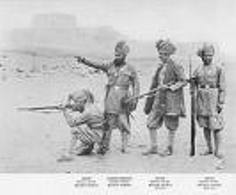|
Khyber Rifles Regiment During the period of British rule the Khyber Rifles was one of eight "Frontier Corps" or para-military units recruited from the tribesmen of the North West Frontier, serving as auxiliaries for the regular British Indian Army. Raised in the early 1880s as the Khyber Jezailchis, the Khyber Rifles was recruited from Afridi tribesmen, with British commanders seconded from regular Indian regiments. Subordinate officers were Afridis.
Khyber Regiment Riflemen
The first commandant who is still revered as a soldier of unsurpassed competence and vision was Sir Robert Warburton, son of an Anglo-Irish father, Robert Warburton, of the Bengal Artillery, and his wife Shah Jehan Begum, an Afghan princess. Sir Robert remained the commandant until his retirement in 1899. His deputy, Nawab Sir Aslam Khan Saddozai, the first Muslim commandant, succeeded him. The headquarters of the Khyber Rifles was at Landi Kotal and their prime role was to guard the Khyber Pass. The three main garrisons of the regiment were Landi Kotal at the western end of the Pass, Fort Maude to the east and Ali Masjid in the centreThe badge of the Corps comprised two crossed Afghan daggers with the words KHYBER above and RIFLES below. While the Indian Army as a whole was noted for its colourful and elaborate dress uniforms prior to 1914, the various units of the Frontier Corps wore only plain khaki drill uniforms and turbans.
|
